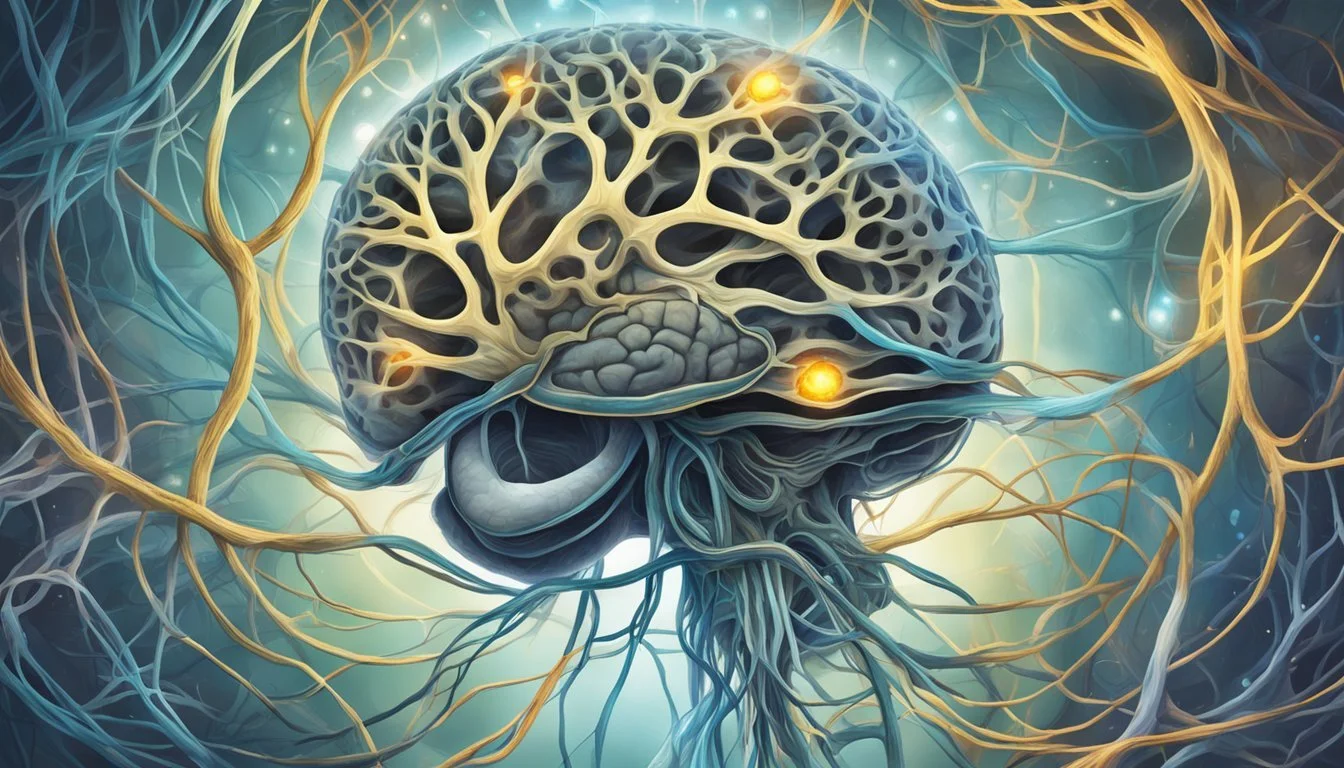The Role of the Fear Center in Posttraumatic Stress Disorder
The amygdala plays a crucial role in processing emotions and fear responses, making it a key area of focus in understanding Post-Traumatic Stress Disorder (PTSD). This small, almond-shaped structure in the brain becomes hyperactive in individuals with PTSD, leading to heightened fear reactions and difficulties regulating emotions.
Research has shown that PTSD can cause changes in amygdala volume and function, contributing to the persistent symptoms experienced by those with the disorder. Studies on veterans with PTSD have revealed mixed results regarding amygdala size, likely due to the complex interplay of factors affecting brain structure in trauma survivors.
The amygdala's dysregulation in PTSD impacts its connections with other brain regions, such as the prefrontal cortex and hippocampus. This altered neural circuitry contributes to the hypervigilance, intrusive memories, and emotional numbing characteristic of PTSD. Understanding these brain changes provides valuable insights for developing more effective treatments and interventions for individuals struggling with trauma-related disorders.
Understanding PTSD
Post-Traumatic Stress Disorder (PTSD) is a serious psychiatric condition that can develop after exposure to traumatic events. It affects millions of people worldwide and can cause significant distress and functional impairment.
Definition and Prevalence
PTSD is a mental health disorder triggered by experiencing or witnessing a terrifying event. It's characterized by persistent symptoms that interfere with daily life.
The prevalence of PTSD varies across populations. In the general population, lifetime prevalence is estimated at 6-8%. Rates are higher in specific groups:
Combat veterans: 10-30%
Sexual assault survivors: 30-50%
Childhood abuse survivors: 35-50%
PTSD can affect people of all ages, but risk increases with repeated or prolonged trauma exposure.
Symptoms and Diagnosis
PTSD symptoms fall into four main categories:
Re-experiencing: Flashbacks, nightmares, intrusive thoughts
Avoidance: Steering clear of trauma reminders
Negative changes in thoughts/mood: Guilt, shame, emotional numbness
Hyperarousal: Irritability, hypervigilance, exaggerated startle response
Diagnosis requires symptoms lasting over a month and causing significant distress or functional impairment. A mental health professional can diagnose PTSD through clinical interviews and standardized assessments.
Symptoms often fluctuate in intensity over time. Some individuals experience delayed-onset PTSD, with symptoms emerging months or years after the traumatic event.
Risk Factors and Vulnerability
Not everyone exposed to trauma develops PTSD. Several factors influence vulnerability:
Biological factors:
Genetics
Brain structure and function
Stress hormone regulation
Psychological factors:
Prior mental health issues
Coping strategies
Personality traits
Environmental factors:
Trauma severity and duration
Lack of social support
Additional life stressors
Childhood trauma, particularly physical or sexual abuse, significantly increases PTSD risk in adulthood. Combat exposure and intimate partner violence are also strong risk factors.
Protective factors like resilience, strong social connections, and access to mental health care can reduce PTSD risk or severity.
The Amygdala's Role in PTSD
The amygdala plays a crucial role in the development and maintenance of post-traumatic stress disorder (PTSD). This brain structure is intimately involved in emotional processing, fear responses, and stress reactivity.
Amygdala Function and Structure
The amygdala is a small almond-shaped structure located deep within the temporal lobes of the brain. It consists of several nuclei, including the lateral nucleus, central nucleus, and basolateral complex. These nuclei work together to process emotional information and coordinate appropriate responses.
In PTSD, the amygdala often shows heightened activity and altered connectivity with other brain regions. This hyperactivation contributes to the intense emotional reactions and persistent fear responses characteristic of the disorder.
Research has shown that individuals with PTSD may have differences in amygdala volume compared to those without the condition. These structural changes can impact the brain's ability to regulate emotions and process traumatic memories effectively.
Amygdala and Emotional Processing
The amygdala is central to emotional processing, particularly in relation to fear and anxiety. It plays a key role in fear acquisition, conditioning, and generalization. In PTSD, the amygdala's function in these processes is often dysregulated.
During fear acquisition, the amygdala associates neutral stimuli with threatening experiences. This process becomes overactive in PTSD, leading to exaggerated fear responses to harmless triggers.
Fear generalization, where the fear response extends to similar but non-threatening stimuli, is also mediated by the amygdala. In PTSD, this generalization can become overly broad, causing individuals to react fearfully to a wide range of innocuous situations.
The amygdala is also involved in fear extinction, the process of learning that a previously threatening stimulus is now safe. PTSD often involves impaired fear extinction, contributing to the persistence of symptoms.
Stress Reactivity and the Amygdala
The amygdala is highly responsive to stress and plays a significant role in the body's stress response. In PTSD, this stress reactivity is often heightened, leading to exaggerated responses to both traumatic reminders and everyday stressors.
Amygdala activation during stress triggers the release of stress hormones and initiates the fight-or-flight response. In individuals with PTSD, this activation can occur more frequently and intensely, even in the absence of real danger.
The amygdala's connections with other brain regions, such as the prefrontal cortex, are also important for stress regulation. PTSD often involves disrupted connectivity between these areas, impairing the brain's ability to modulate stress responses effectively.
Research has shown that successful PTSD treatment can lead to changes in amygdala function, highlighting its importance as a target for therapeutic interventions.
Prefrontal Cortex and PTSD
The prefrontal cortex plays a crucial role in PTSD, affecting emotion regulation and fear processing. Research has revealed significant alterations in this brain region among individuals with PTSD.
Medial Prefrontal Cortex Involvement
The medial prefrontal cortex (mPFC) is a key area implicated in PTSD. Structural MRI studies have shown volumetric reductions in the mPFC of PTSD patients. These changes are associated with impaired fear extinction and emotion regulation.
Functional magnetic resonance imaging (fMRI) has revealed altered activation patterns in the mPFC during fear processing tasks. PTSD patients often exhibit hypoactivation in this region when exposed to trauma-related stimuli.
The mPFC's reduced activity may contribute to difficulties in modulating fear responses and managing emotional reactions to trauma reminders.
Structural and Functional Connectivity
PTSD affects both structural and functional connectivity within prefrontal cortical areas. Diffusion tensor imaging studies have shown disrupted white matter integrity in prefrontal regions.
Resting-state fMRI analyses have revealed altered functional connectivity between the prefrontal cortex and other brain regions, particularly the amygdala. This dysconnectivity may underlie the impaired top-down regulation of fear and anxiety responses in PTSD.
Neurocircuit models of PTSD emphasize the importance of prefrontal-amygdala interactions. Weakened prefrontal control over the amygdala is thought to contribute to hyperarousal and re-experiencing symptoms.
These connectivity alterations may explain the persistent fear responses and difficulty in contextualizing traumatic memories observed in PTSD patients.
Neuroimaging Insights
Neuroimaging techniques have revolutionized our understanding of the brain's role in PTSD. These methods reveal structural and functional changes in key regions associated with fear, memory, and emotion regulation.
MRI and fMRI Studies
Structural MRI studies have identified volumetric changes in PTSD patients' brains. The amygdala often shows increased volume, while the hippocampus typically exhibits reduced size. Functional MRI (fMRI) reveals altered activation patterns in these regions during fear processing and memory tasks.
The insula and anterior cingulate cortex also display abnormal activity in PTSD. fMRI studies show hyperactivation of the amygdala and hypoactivation of the prefrontal cortex during emotional tasks. This imbalance may contribute to the heightened fear responses and difficulty regulating emotions seen in PTSD.
Connectivity patterns between brain regions are also disrupted. Reduced functional connectivity between the prefrontal cortex and amygdala is a common finding, potentially explaining impaired fear extinction in PTSD patients.
Hippocampus and PTSD
The hippocampus plays a crucial role in memory formation and contextual fear learning. Neuroimaging research consistently reports hippocampal volume deficits in PTSD patients. These reductions are particularly pronounced in the CA3 and dentate gyrus subfields.
Longitudinal MRI studies suggest that smaller hippocampal volume may be both a risk factor for developing PTSD and a consequence of chronic stress exposure. Hippocampal volume deficits correlate with symptom severity and impaired declarative memory performance.
Functional neuroimaging reveals altered hippocampal activation during memory encoding and retrieval tasks in PTSD. This dysfunction may contribute to the fragmented and intrusive nature of traumatic memories characteristic of the disorder.
Identifying Biomarkers
Neuroimaging research aims to identify reliable biomarkers for PTSD diagnosis and treatment response. Machine learning algorithms applied to structural and functional MRI data show promise in distinguishing PTSD patients from trauma-exposed controls.
Multimodal imaging approaches combining structural, functional, and connectivity measures provide a more comprehensive view of PTSD neurobiology. These methods may help identify subtypes of PTSD based on distinct neural signatures.
Dimensional approaches linking specific symptom clusters to brain measures offer new insights. For example, hyperarousal symptoms correlate with increased dorsal anterior cingulate cortex activation, while avoidance is associated with altered hippocampal-prefrontal connectivity.
Treatment and Recovery
Effective PTSD treatments target the amygdala and other brain regions involved in fear processing. Evidence-based therapies, alternative approaches, and outcome measurements play crucial roles in addressing PTSD symptoms and promoting recovery.
Evidence-Based Therapies
Prolonged Exposure (PE) therapy helps patients confront trauma-related memories and situations. This approach reduces amygdala hyperactivity over time. Cognitive Processing Therapy (CPT) focuses on changing unhelpful thoughts about traumatic events.
Eye Movement Desensitization and Reprocessing (EMDR) combines exposure therapy with bilateral stimulation. It aims to reprocess traumatic memories and reduce their emotional impact.
Cognitive Behavioral Therapy (CBT) addresses negative thought patterns and behaviors associated with PTSD. It helps patients develop coping strategies and manage symptoms effectively.
Alternative Approaches
Mindfulness-based interventions show promise in reducing PTSD symptoms. These techniques promote present-moment awareness and emotional regulation.
Brain stimulation methods, such as transcranial magnetic stimulation, target specific brain regions involved in PTSD. These approaches may modulate amygdala activity and improve symptoms.
Social support plays a crucial role in PTSD recovery. Group therapy and peer support programs can provide valuable connections and shared experiences.
Measuring Treatment Outcomes
The Beck Depression Inventory and Beck Anxiety Inventory assess mood and anxiety symptoms in PTSD patients. These tools help track progress during treatment.
The PTSD Checklist for DSM-5 (PCL-5) measures PTSD symptom severity. It provides a standardized assessment of treatment effectiveness.
The Mini International Neuropsychiatric Interview helps diagnose PTSD and comorbid conditions. This structured interview ensures accurate diagnosis and treatment planning.
Functional brain imaging can measure changes in amygdala activity throughout treatment. These scans provide objective data on neural responses to therapy.
Future Directions
Research into the amygdala's role in PTSD continues to evolve, with promising avenues for improved diagnosis and treatment. New technologies and approaches are shedding light on neural mechanisms and individual differences in stress responses.
Advancements in Neuroimaging
High-resolution functional MRI now allows researchers to examine amygdala subnuclei activity in unprecedented detail. This technique may reveal how specific nuclei contribute to fear processing and PTSD symptoms. Multimodal imaging combining fMRI with PET or MEG provides a more comprehensive view of amygdala function.
Advanced machine learning algorithms applied to neuroimaging data could identify subtle patterns associated with PTSD risk or treatment response. These tools may enable personalized interventions based on individual brain characteristics.
Optogenetic techniques in animal models allow precise control of amygdala circuits. This approach helps elucidate causal relationships between neural activity and behavior relevant to PTSD.
Understanding Resilience and Adaptation
Studying individuals who experience trauma without developing PTSD offers insights into protective factors. Researchers like Kerry Ressler and Tanja Jovanovic examine genetic, epigenetic, and environmental influences on stress resilience.
Longitudinal studies tracking neural and behavioral changes after trauma exposure are crucial. These investigations may reveal how the brain adapts over time and why some recover while others develop chronic PTSD.
Exploring interactions between the amygdala, prefrontal cortex, and hippocampus in resilient individuals could inform new treatment approaches. Enhancing natural adaptive processes may prove more effective than targeting specific symptoms.





